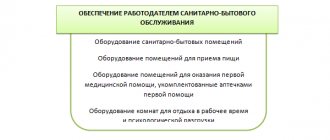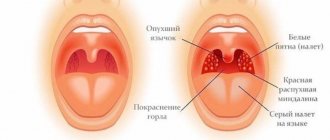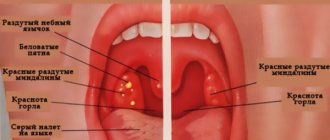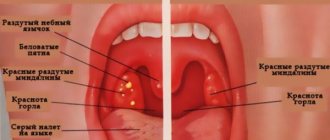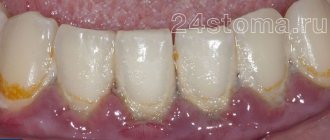Author:
- Elena Vitalievna Naumova, otolaryngologist, leading doctor of the clinic
2.81 (Votes: 16)
If the temperature exceeds 38°C, the lymph nodes are inflamed, white plaque has spread to the tonsils, the back wall of the pharynx, then antimicrobial therapy cannot be avoided. To prevent purulent tonsillitis from developing into a chronic process, taking antibacterial drugs is mandatory. Medicines suppress the growth of bacteria, prevent infection of family members, and reduce the likelihood of complications.
Only an ENT doctor can figure out which antibiotic is effective and safe for purulent sore throat.
Main groups of drugs
Sore throat is provoked by different types of opportunistic microorganisms and treatment depends on the specific causative agent of the disease. First of all, the ENT doctor will give a referral for a blood test and bacterial culture from the tonsils to detect antibiotic resistance.
Most often, purulent tonsillitis is treated with systemic antibiotics:
- Penicillin series. They have fewer contraindications, so they are often prescribed to children and adults with intolerance to other groups of antibiotics. Penicillins are effective only at the initial stage, when ulcers have not formed. It is worth noting that they are not prescribed if the patient has a history of bronchial asthma or urticaria. During pregnancy, they are prescribed only when absolutely necessary in the early stages.
- Cephalosporins. They are beneficial in severe cases of the disease. They are low toxic and effective from the first day of use. Can be prescribed to pregnant women.
- Macrolides. Prescribed if there is no effect from taking medications of the first two groups. Macrolides have an extended list of contraindications and are taken in a short course. It is worth noting that they are prohibited during pregnancy and breastfeeding.
- Lincosamides. Used for frequent exacerbations of purulent tonsillitis.
General therapy should be comprehensive, i.e. It is possible to speed up recovery and remove the pathogen with oral antibiotics and local treatment. Local antibiotics for purulent sore throat are prescribed to young children and pregnant women.
Treatment of tonsillitis
Treatment of this disease requires mandatory medical supervision, since tonsillitis is a bacterial infection and is treated with the use of antibacterial drugs. Courses of antibiotics are quite long - 7-10 days. It is very important to maintain the full course of taking medications, even despite the possible rapid restoration of good health. The bacteria must be completely destroyed with antibiotics. If this does not happen, relapses of the disease are possible and the risk of complications is very high.
In addition, in the treatment of tonsillitis, a variety of rinsing options with antiseptic solutions (iodine, salt and baking soda, chamomile decoction, etc.) are often used. The purpose of rinsing is to remove plaque from the tonsils, wash out all the contents from the gaps (indentations) of the tonsils and, thereby, speed up recovery.
At elevated body temperatures, antipyretic drugs are used, and warm, generous fluids are recommended. An important point in the treatment of sore throat is adherence to strict bed rest throughout the febrile period. That is, while the child has an elevated body temperature, walking on the street and outdoor games are strictly prohibited. Failure to comply with bed rest, as well as failure to comply with the duration of the course of antibiotics, very often leads to complications.
In order to monitor the occurrence of complications and the effectiveness of antibacterial therapy at the beginning and at the end of treatment for acute tonsillitis, a number of laboratory tests are required. This is a general blood test and a general urinalysis, and at the end of treatment, in addition to these, an electrocardiogram and a biochemical blood test are prescribed.
If the child has recovered (i.e. normal temperature, normal blood tests), then a few days after the end of the course of treatment it is possible to visit a preschool or school institution, but with a mandatory limitation of physical activity for two weeks.
In case of acute tonsillitis, there are no pronounced dietary restrictions, except that food should not injure the inflamed tonsils (it is better to exclude solid foods such as crackers, crackers, and cookies). Of course, be sure to drink plenty of fluids to detoxify the body. Depending on the age and body weight of the child, there are recommended volumes of fluid, which, as a rule, should be increased by 30% during the period of illness.
Complications of tonsillitis
Acute streptococcal tonsillitis is terrible for its complications. With streptococcal infections, the main group of complications are the so-called rheumatoid diseases (connective tissue diseases), which cause damage to the valvular apparatus of the heart with the formation of heart defects and kidney damage with the formation of glomerulonephritis and possible renal failure.
Prevention of tonsillitis
Measures to prevent bacterial tonsillitis logically follow from the factors that cause this disease:
- You should try to avoid contact with patients in the acute phase of the disease. If there are several children in a family and one of them suffers from acute tonsillitis, then even the children’s toys should be separated or sanitized (washed with hot water and soapy water);
- strictly observe basic hygiene rules;
- avoid hypothermia. In the cold season, the neck should be covered, you need to ensure that children do not eat snow, do not lick icicles and do not eat ice cream in large pieces.
- If there is chronic tonsillitis in the family (parents), it is necessary to conduct an examination for the carriage of microbes in the nasopharynx and use individual dishes.
Director of the private unitary enterprise “Dechko and K” (trademark “Good Doctor”), first category doctor A.V. Dechko.
The conversation was conducted by a correspondent from the magazine “Malyshok”
Anastasia SHUNTO
Reception features
Each antibacterial drug is taken differently. The dosage, regimen, and duration of therapy are selected by the ENT doctor individually for each patient. Penicillins are usually eliminated from the body quickly, so treatment with drugs of this group involves frequent taking of tablets. Cephalosporins in tablet form are taken every 6-12 hours.
Uncontrolled use of antibiotics entails a decrease in the sensitivity of bacteria to the drug and a lack of treatment effect, and subsequently to the development of persistent resistance of the patient's microflora to antibacterial drugs.
Antimicrobial agents are taken one hour before meals or two hours after meals. Thus, the absorption of the active substance is higher.
Causes and routes of infection for sore throat
The inflammatory process develops under the influence of pathogenic microflora. The causative agent of the pathology is considered to be:
- staphylococcal;
- streptococcal;
- energy virus;
- pneumococcal;
- diplococcal infection.
The main ways of contracting tonsillitis are:
- airborne - when sneezing, coughing or talking to a carrier;
- hematogenous - microflora moves along with the blood from foci of inflammation located in other areas;
- enteral - pathogens enter with food (uncooked milk), through unwashed hands;
- endogenous – formed against the background of caries, gastroenteritis, purulent sinusitis;
- traumatic – formed during operations on the ENT organs.
Sore throat occurs at any age, the risk of its occurrence is associated with an inadequate diet, without a sufficient amount of nutrients, overwork, and severe hypothermia. The pronounced activity of pathogens indicates dysfunction of the immune system.
Release form
Depending on the stage of development of the disease, the ENT doctor prescribes different types of antibiotics:
- Tablets and syrups. Used as the disease progresses. Usually the drug effect is noticeable 2-4 days after the start of administration.
- Local medications (sprays, lozenges). They are used as an addition to the main therapy, since they only relieve acute pain when swallowing saliva, and do not kill completely pathogenic bacteria.
- Injections for intramuscular and intravenous administration are prescribed for advanced stages of angina, when the patient cannot swallow a tablet. Basically, antibiotics of the bicillin group are used as active substances once. The effectiveness of injections is much higher, since the active substance is evenly distributed throughout the tissues. A high concentration of the drug lasts longer, so the result is visible faster.
Important to remember! The earlier the diagnosis is made and rational therapy for acute purulent tonsillitis is prescribed, the greater the chances of curing the disease without developing serious complications. At the first manifestations of purulent tonsillitis, do not waste precious time self-medicating, consult a doctor! This will save you and your loved ones from serious consequences!
Sore throat: main complications
Everyone has probably encountered tonsillitis, or, as it is also called, acute tonsillitis. Some heard about the disease from a friend, while others themselves felt the characteristic symptoms - high fever with chills, severe weakness and a sharp pain in the throat when swallowing. What is a sore throat and why is it so dangerous?
Angina and its treatment
Acute tonsillitis is an infectious disease that can be caused by various types of pathological microorganisms, but most often the causative agent of sore throat is beta-hemolytic streptococcus.
Once upon a time, sore throat was considered a fairly serious disease, which in some cases could even lead to death, but the situation has changed radically since the discovery of antibiotics. Nowadays, sore throat responds well to treatment with antibacterial drugs, provided that the medicine is correctly selected and the treatment regimen is followed.
Sore throat - cold, sore throat or tonsillitis?
A sore throat is a common symptom of a cold (an acute respiratory viral disease). However, a sore throat with a cold lasts one to two days and may go away without treatment. A common symptom of a cold is a runny nose and nasal congestion.
Sore throat, a disease caused by the bacterium streptococcus, is also a common cause of sore throat. With a sore throat, the sore throat is intense, lasts longer and is accompanied by a number of common symptoms.
Tonsillitis is a painful inflammation of the tonsils, which are located at the back of the throat. Also causes a sore throat.
What causes a sore throat during a cold - bacteria or viruses?
Most often, a sore throat during a cold is caused by various viruses and may be accompanied by other symptoms of viral diseases - runny nose, fever, cough, red eyes.
How to treat a sore throat with a cold?
Although there are no medications that directly target the viruses that cause colds, there are treatments that can help relieve a person's cold. Drinking plenty of warm fluids, salt gargles, and taking antipyretic medications help reduce cold symptoms.
Do medications improve the symptoms of a sore throat due to a cold?
Antipyretics relieve cold symptoms and sore throats. But the effectiveness of these drugs should not be exaggerated.
- Nonsteroidal anti-inflammatory drugs such as ibuprofen or naproxen relieve sore throats associated with colds. There are many commercial preparations that contain these substances. We remind you that aspirin should not be given to children to avoid the development of Reye's syndrome, which can cause brain damage and death .
- Various sprays with antiseptics and anesthetics reduce the intensity of sore throat.
- Vasoconstrictor nasal sprays and drops improve the symptoms of sore throat during colds by applying to the back wall of the pharynx. It is not recommended to use them for more than 3 days - they become ineffective and can cause even greater swelling of the mucous membrane
Antibiotics do not need to be used to treat colds and sore throats because all colds are caused by viruses .
How does a sore throat with strep throat differ from a sore throat with a cold?
Inflammation in the pharynx during sore throat is caused by streptococcal bacteria. To become infected with tonsillitis, airborne contact with a patient or carrier of streptococcal infection is necessary. Despite the fact that tonsillitis most often occurs in children aged 5 to 15 years, adults can also get it. To accurately diagnose a sore throat, the attending physician can take a rapid test for streptococcus or send the material for bacterial testing to a laboratory. Most often, the diagnosis is made by a doctor based on the leading symptoms of sore throat - high fever, acute sore throat, white plaque on the pharyngeal mucosa and enlarged regional lymph nodes in the neck.
Why is a sore throat with a sore throat more dangerous than with a cold?
Streptococcal tonsillitis can cause such a serious complication as rheumatism with damage to the heart valves. Therefore, it is very important to start proper treatment of sore throat on time. With proper treatment, the symptoms of sore throat disappear within 10 days.
Is a sore throat different from a sore throat and a cold?
With a sore throat, the pain in the throat is more intense and differs in a number of features
- sudden onset
- loss of appetite
- pain when swallowing
- redness of the tonsils with white plaques
- high fever
Should you seek help from a doctor if you suspect streptococcal sore throat?
On the first day of illness, sore throat with a cold and sore throat can be very similar. If you still suspect the presence of a sore throat, you must definitely consult a doctor to establish the correct diagnosis and carry out therapy.
Treatment for sore throat with sore throat?
For angina, the use of antibiotics is mandatory . Oral antibiotics of the penicillin group are most often prescribed. If you are allergic to these antibiotics, your doctor will select another group. You must strictly follow the prescribed regimen of taking the antibacterial drug, even if you feel better during the first and second days.
Why does the sore throat with streptococcal sore throat not improve?
Sometimes, despite taking medications, the condition of a sore throat does not improve within two to three days. This may indicate the development of complications. A visit to the doctor is necessary to clarify treatment. Be sure to consult a doctor if you have the following symptoms:
- fever for more than 2-3 days while taking antibiotics
- nausea or vomiting
- earache
- severe headache
- neck muscle tension
- the appearance of a skin rash
- cough
- shortness of breath
What is the difference between a sore throat with a cold and a sore throat with tonsillitis?
Sometimes a sore throat occurs due to tonsillitis, an inflammation of the tonsils (lymphatic tissue) in the throat. Tonsillitis can be caused by both viruses and bacteria. The tonsils protect the body from infection through the pharynx, but they themselves can be affected by an infectious agent. When this happens, the affected tonsils cause severe pain.
How do the symptoms of tonsillitis differ from a sore throat due to a cold?
A cold is usually accompanied by symptoms such as runny nose, nasal congestion, and cough. With tonsillitis, there are no these symptoms, but there is swelling of the tonsils and a yellowish coating on them. In addition, the following symptoms occur with tonsillitis:
- difficulty breathing
- fever
- hoarseness of voice
- pain when swallowing
- enlarged lymph nodes in the neck
How to treat sore throat due to tonsillitis?
If tonsillitis is caused by bacterial flora, antibiotics are necessary. The decision is made by the attending physician. Antibiotics are useless for viral infections. In this case, you should adhere to the tactics of treating sore throat with a cold. In any case, if you have a sore throat, you should follow the general recommendations:
- be at rest
- drink plenty of warm liquid
- eat soft, warm foods, avoid rough and spicy foods
- use medicinal aerosols
- If you have a fever, use antipyretic drugs
With frequent exacerbations of tonsillitis, it is necessary to consult a doctor to decide on tonsillectomy (removal of the tonsils).
For all questions related to the pathology of the ENT organs, you can contact the experienced ENT doctors of the ANDROMEDA Clinic.
Otorhinolaryngologist of the highest category Morenko M.V.
How to treat purulent sore throat
The list of therapeutic measures is as follows:
- gargling with antiseptic solutions to flush out pathogenic microorganisms. For this purpose, furatsilin, hydrogen peroxide, chamomile and calendula decoctions, and rotokan are used.
- antibiotics of the cephalosporin and macrolide groups kill pathogenic flora. They are prescribed by the doctor individually according to the scheme.
- symptomatic therapy is aimed at alleviating the general condition of the patient. These include antipyretic, anti-inflammatory, antihistamines, and vitamins.
Symptoms of the disease
Depending on the form of the disease, the type of pathogen and the degree of angina, the general clinical symptoms will differ:
- Catarrhal. With this form of sore throat, the infection spreads to the mucous membrane of the tonsils. The main symptoms are: sore throat, which reaches maximum strength during swallowing, redness and swelling of the tonsils. Against the background of the inflammatory process, an increase in temperature is observed.
- Follicular. With angina, not only the mucous membrane is affected, but also the lymphoid follicles. The primary symptom is a sore throat, which begins acutely and is accompanied by a sharp rise in temperature to high levels. A person feels weakness, aches in muscles and joints, and headaches. On the tonsils, festering follicles measuring 1–3 mm appear, which open on the second to fourth day.
- Lacunar tonsillitis, which is characterized by a deep degree of damage to the tonsils, accompanied by the accumulation of pus in the lacunae. The tonsils become bright red, with a yellow-white coating clearly visible on them. Sore throat is accompanied by general intoxication of the body.
- Necrotizing tonsillitis is quite rare and is characterized by the presence of necrotic areas.
The onset of symptoms begins after the end of the incubation period. Against the background of elevated temperature, febrile convulsions may occur - severe tension in the muscles, followed by shuddering and twitching.
Sore throat - symptoms and treatment
The incubation period is up to 2 days. The beginning is acute.
Syndromes:
- general infectious intoxication;
- tonsillitis (acute, purulent);
- anglemaxillary lymphadenitis.
Fever, chills and general fatigue
The first signs of a sore throat are an increase in body temperature to 38-40°C, chills, weakness and sweating. Fever of a constant type. Heart rate corresponds to body temperature. The skin of the face is hyperemic, the eyes are shiny.
Headaches and muscle aches
With a sore throat, a headache appears (dull, without clear localization) and severe aches in the muscles and joints.
Sore throat
On the first day of the disease, sore throat appears when swallowing, then becomes a permanent manifestation and can radiate to the ear.
Enlarged and painful lymph nodes
The maxillary lymph nodes enlarge, become very painful, have a dense elastic consistency, and are not fused to each other and the surrounding tissues.
The data obtained during pharyngoscopy are very characteristic:
- mouth opening is free;
- the palatine arches, uvula, tonsils and soft palate are clearly hyperemic in the first days.
Main manifestations of tonsillitis
Enlargement and redness of the tonsils. The tonsils are swollen, red (“juicy”), which corresponds to catarrhal tonsillitis. Usually this stage of the disease is not recognized (they do not have time) and bright visualization occurs on the second day of the disease, when white follicles 2-3 mm in size form in the tonsil tissue, rising above the surface of the tonsil tissue - follicular tonsillitis develops.
From the third day, a yellow-white discharge (pus) appears in the lacunae - follicular-lacunar tonsillitis.
What does a throat look like with a sore throat?
Further, in severe forms, necrotizing tonsillitis occurs: the tonsils are dark gray in color, after the purulent-necrotic masses are rejected, tissue defects remain.
It must be remembered that purulent plaque in case of tonsillitis does not spread beyond the tonsils, is easily removed, and does not sink in water - the appearance of any other variants of the course is a reason to doubt the diagnosis.[2][3][5][6]
Phlegmonous tonsillitis
Phlegmonous tonsillitis is the most severe form of tonsillitis. It is characterized by the development in the tonsil tissue, often of a unilateral purulent focus without clear boundaries. Intoxication sharply increases, severe pain on the affected side and swelling occurs, and it becomes difficult to open the mouth. The disease requires urgent surgical treatment.
Ulcerative-membranous form of tonsillitis
With the ulcerative-membranous form of tonsillitis, ulcerations occur on the surface of the tonsil tissue, severe pain and plaque, which is easily removed with a spatula.
How does viral and herpes sore throat occur?
“Viral sore throats” have nothing to do with classic streptococcal sore throat. They are only separate syndromes for viral diseases: adenovirus, cytomegalovirus and enterovirus (herpangina) infections and many others. The term “tonsillitis” applies only to diseases caused by group A beta-hemolytic streptococcus. All other inflammations of the tonsil tissue should be called acute or chronic tonsillitis.
For this reason, it is incorrect to distinguish herpetic sore throat, sore throat due to diphtheria , influenza , scarlet fever and infectious mononucleosis .
How does angina occur in children?
In children, the symptoms of sore throat are more pronounced than in adults. Intoxication is more severe, the child is lethargic, refuses to eat, possible abdominal pain, severe headaches, nausea and vomiting.
What symptoms of sore throat should you sound the alarm about?
When to see a doctor:
- when the temperature rises above 37.5 °C;
- severe and painful sore throat;
- severe intoxication;
- soreness of the mandibular lymph nodes.



